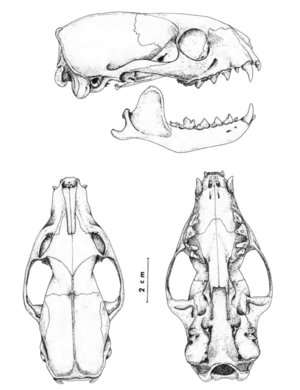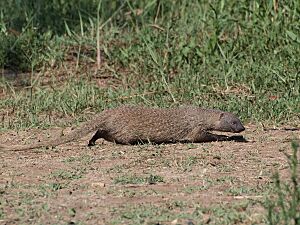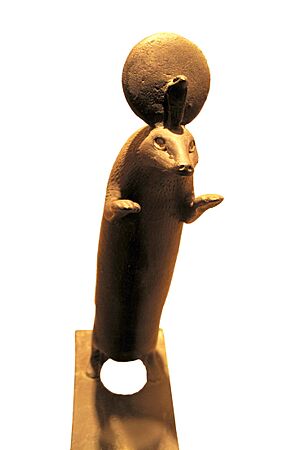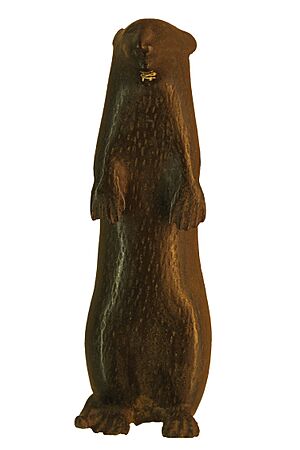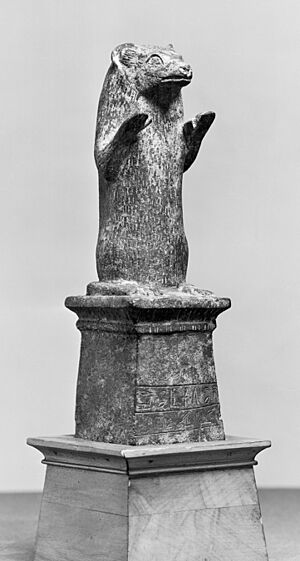Egyptian mongoose facts for kids
Quick facts for kids Egyptian mongoose |
|
|---|---|
 |
|
| Conservation status | |
| Scientific classification | |
| Genus: |
Herpestes
|
| Species: |
ichneumon
|
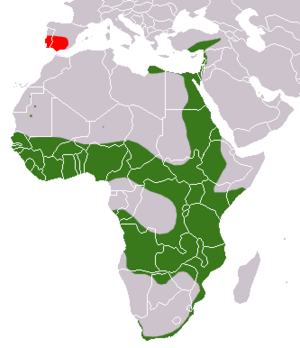 |
|
| Egyptian mongoose range (green – native, red – possibly introduced) |
|
| Synonyms | |
|
Viverra ichneumon Linnaeus, 1758 |
|
The Egyptian mongoose (Herpestes ichneumon) is a type of mongoose found in parts of Africa, the Middle East, and the Iberian Peninsula (Spain and Portugal). It lives in warm, grassy areas and near water. Scientists are not sure if it naturally arrived in Spain and Portugal or if people brought it there a long time ago. Because it is found in many places, it is listed as Least Concern on the IUCN Red List, meaning it is not currently in danger of disappearing.
Contents
What Does an Egyptian Mongoose Look Like?
The Egyptian mongoose has long, rough fur that can be grey or reddish-brown. Its fur often has small brown and yellow spots. It has a pointed nose and small ears. Its body is slim and measures about 48 to 60 cm (19 to 24 in) long. Its tail is long, about 33 to 54 cm (13 to 21 in), and has a black tip. The fur around its eyes and on its back feet is very thin.
Egyptian mongooses have 35 to 40 teeth. Some of these teeth are very sharp, like scissors, and are used for cutting meat. An adult mongoose usually weighs between 1.7 and 4 kg (3.7 and 8.8 lb). In some places, like Portugal, female mongooses can be smaller than males.
Where Do Egyptian Mongooses Live?
Egyptian mongooses like to live in wet, marshy areas. They are often found near streams, rivers, lakes, and along coastlines. In places like the Iberian Peninsula, they prefer areas close to rivers with lots of plants. They do not live in deserts.
They are found in many countries, including:
- Portugal (from the Douro River south)
- Spain (from the central plateau to the Strait of Gibraltar)
- North Africa (along the coast from Western Sahara to Tunisia)
- Northern Egypt and the Sinai Peninsula
- Palestinian territories (Gaza Strip and West Bank)
- Western Syria
- Southern Turkey (Hatay and Adana Provinces)
- Sudan (near human settlements and in national parks)
- Ethiopia (in the highlands, up to 3,000 m or 9,800 ft high)
- Senegal (in Niokolo-Koba National Park)
- Guinea (in National Park of Upper Niger)
- Gabon (in Moukalaba-Doudou National Park)
- Republic of Congo (in Odzala-Kokoua National Park)
- Tanzania (in Mkomazi National Park)
How Did They Get to the Iberian Peninsula?
Scientists have different ideas about how Egyptian mongooses came to live in Spain and Portugal:
- Some believe they were brought by people during the Muslim invasion in the 8th century.
- Other scientists found old mongoose bones in Spain and Portugal. These bones are about 2,000 years old. This suggests that the Romans might have brought them to help control rats and mice.
- Another idea is that they walked there naturally during the Ice Age. At that time, sea levels were lower, and there might have been a land bridge connecting Africa and Europe.
What Do Egyptian Mongooses Do?
Egyptian mongooses are active during the day. They can be seen alone, in pairs, or in small groups of up to five. Male mongooses often protect their own areas. They might share their space with one or more females. Female mongooses also have their own areas, especially when they are raising their young.
What Do They Eat?
Egyptian mongooses eat many different things. Their diet includes:
- Small animals like rodents, fish, birds, reptiles, and amphibians.
- Insects.
- Fruits and eggs.
They are clever at opening eggs. They throw the egg between their legs against a hard surface, like a rock or wall, to crack it open.
In Spain, their diet includes rabbits, lizards, toads, shrews, skinks, ducks, and even wild boar meat. In Nigeria, they eat different types of rats, mice, shrews, toads, and snakes. They are known to attack and eat venomous snakes. They are even resistant to the venom of some dangerous snakes.
Interestingly, in Spain, Egyptian mongooses are seen less often in areas where the Iberian lynx has been brought back.
How Do They Have Babies?
In Spain, Egyptian mongooses usually find partners in spring, between February and June. After about 11 weeks, two or three babies are born. The babies are born without fur and open their eyes after about a week. The mother takes care of her young for up to a year, sometimes even longer. The young mongooses start looking for food on their own when they are about four months old. In the wild, Egyptian mongooses can live for about 12 years. One mongoose in a zoo lived for over 20 years!
Threats to Egyptian Mongooses
Sometimes, Egyptian mongooses are caught in traps set for other animals, especially in farming areas. In some parts of Africa, their dried heads are used in traditional rituals.
Protecting Egyptian Mongooses
The Egyptian mongoose is a protected animal in many places. It is listed in international agreements that help protect wildlife. In Israel, for example, it is against the law to hunt them without a special permit.
Egyptian Mongooses in Culture
Ancient Egyptians thought mongooses were special. Scientists have found mummified remains of Egyptian mongooses in ancient tombs. In one tomb, there is a drawing of an Egyptian mongoose on a leash.
The American poet John Greenleaf Whittier wrote a poem about an ichneumon (another name for the Egyptian mongoose) in the 1800s. Also, in the famous Sherlock Holmes stories, there is a mention of an ichneumon. However, based on the description, it was probably an Indian grey mongoose instead.
See also
- Ichneumon (In medieval zoology)



